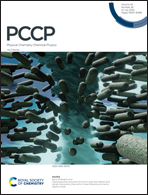Pressure and temperature stability boundaries of cubic SiC polymorphs: a first-principles investigation
Abstract
A better understanding of the effects of temperature and pressure on the wide gap SiC semiconductor is necessary for both (i) an improvement of the performance of this compound in a variety of technological applications and (ii) a clarification of controversial issues related to the stability of its cubic polymorphs at high pressure and high temperature. Bearing in mind this double demand, we perform first-principles calculations of the phonon band structures, vibrational density of states, and thermal and mode Grüneisen parameters of the zinc blende (B3) and rock-salt (B1) cubic polymorphs of 3C–SiC covering pressures and temperatures up to 120 GPa and 3000 K, respectively. Under a martensitic description of the B3–B1 transformation, we found that the large hysteresis pressure range observed at room temperature (35–100 GPa) disappears at around 1100 K. The calculated Clapeyron slope of this transformation is slightly negative, with average values of −2.9 MPa K−1 in the 0–3000 K interval and −3.7 MPa K−1 at 2000 K. We also study the decomposition reaction of the two cubic polymorphs into their elemental constituents (C and Si), finding a decreasing (increasing) decomposition temperature for the B3 (B1) phase as the pressure is applied. All these results are sustained by good agreement with other recently reported experimental and theoretical thermodynamic data that have also been evaluated under our quasi-harmonic approximation framework.



 Please wait while we load your content...
Please wait while we load your content...